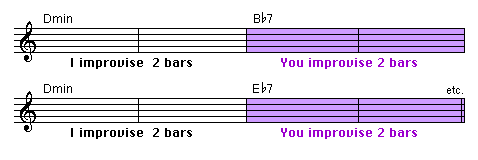(Down - Up -
Top - Links)
S 8.4 - Phrasing : Swapping
Twos
Swapping twos (2 bars) or fours (4 bars) between two soloists is
a common feature in Jazz improvisation. We will use this approach
in this song.
I start with the first two bars of each 4 bar
phrase, you complete the phrase by improvising over the second
two bars.
Swapping Twos

Keep it simple. Just listen to what I play and react to it by
repeating the rhythm or completing the sentence in your own
way.
Unfortunately I cannot hear what you play (as in a real
life performance), but one-way interaction is better than
none.
I have recorded two tracks. Each one starts immediately
with swapping twos.
The format is : ABC - ABC - AB
- On
Cruisin' 1 I play every first 2 bars of
each phrase
- On Cruisin' 2 I play every last 2
bars of each phrase
|
To make these tracks I swapped twos with myself. You can listen
to the complete result on Cruisin' 3. I
used vibes for the solo and played only single note lines. I also
took out the dynamics on the midi file. (Not too sure if these
come across properly on playback.)
|
(Down - Up -
Top - Links)
S 8.5 - Practice : Dominant
Chord - Mode Combination
|
To convert the Chord - Mode
practice pages for the Dominant Chord - Mixolydian
mode : lower the 7ths of the chord and mode
(the upper pink square note heads) by a
semitone. For example in the key of C the B
becomes a Bb, in the key of F the E becomes and Eb, and so
on. |
Practise the Dominant 9th chord - Mixolydian mode combination
in all keys in two ways.
1. Chord tones up to the 9th, then the
Mixolydian mode down.
Audio 8.9

2. Mixolydian mode up to the 9th, then
dominant 9th chord tones down.
Audio 8.10

To fit a 4 bar segment play the exercise as shown above. This way
you can use the Circle of 5ths Play-a-Long track (major) for the
exercise.
When practising without a backing track go up and
down the pattern three times in each key.
(Down - Up -
Top - Links)
S 8.6 - Session
Materials
(Up - Top - Links)
© 2003 Michael Furstner
(Jazclass)